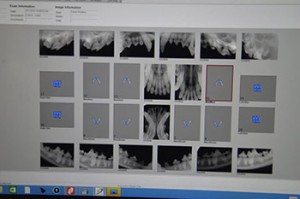You are doing the right thing for your pet
The night before your pet’s dental appointment, you will feed him as usual. Either at your bedtime or at midnight (whichever is sooner), you will pick up the food bowl but leave water available. In the morning, you will not give your pet any breakfast (even if he looks pathetically sad and hungry) because you know that fasting will make anesthesia safer.
When you arrive at the hospital, you and your pet will be warmly greeted, and our staff will review the procedure/anesthesia consent forms with you, answering any questions. We will then escort your pet to the treatment area, where his heart will be ausculted (checking for murmurs or abnormal rhythm) and a pre-anesthetic blood panel will be performed to check blood sugar, red blood cell count and liver and kidney values before anesthesia (unless this has already been done within the past 10 days).
After this your pet will be placed in a cage. Pets that seem nervous may be premedicated during this time to make them more comfortable, but most pets settle down quickly once they are placed onto a comfortable padded bed or towel.
 Anesthesia-Safety and Preparation
Anesthesia-Safety and Preparation
Before any procedure a systems check is done of the anesthesia machine and endotracheal tube. An appropriate anesthesia/pain management protocol is determined for each individual pet based on that pet’s needs. We understand that each pet is different, and we are prepared to meet the special needs of your pet. Often this includes an opioid class pain medication in addition to other relaxing or anxiety decreasing agents. At this time an intravenous catheter is inserted into a leg vein. Anesthesia is induced with injectable drugs that help your pet go to sleep quickly and peacefully, at which time an endotracheal tube is inserted into the trachea (breathing tube inserted into the windpipe). The tube is checked for placement, and the pet is connected to the isoflurane gas anesthesia that will keep him asleep during the procedure.
Arizona law mandates that a pet’s heartrate and respiratory rate be monitored every 15 minutes during anesthesia. Here at Indian Bend, we monitor and record both heartrate, respiratory rate, blood pressure and oxygen saturation every ten minutes to make anesthsia as safe as possible.
Comprehensive Oral Health and Treatment (COHAT)
After your pet is safely asleep, the veterinary technician begins the cleaning process with a brief visual assessment and a combination of ultrasonic and hand scaling to get the visible calculus off the teeth. The next step is full mouth digital dental radiographs (xrays). After the veterinarian reviews the radiographs, she and the technician together go through the entire mouth taking measurements of the pockets around each tooth (just like at your human dental appointments). If your pet has any teeth that are broken or infected or have any deep pockets (over 3 mm in dogs), Dr. Gulinson will then call you with a treatment plan. Many pets do have significant enough dental issues that they will have at least one tooth extraction. After Dr. Gulinson addresses whatever dental disease is present, the veterinary technician will finish up with subgingival currettage (removing calculus and plaque from a portion of the tooth under the gumline) and ultrasonic polishing.
Please note that Dr. Gulinson has a special interest in dentistry and is committed to providing excellent dental care to your pet. She has attended continuing education courses in dentistry and consults frequently with the local veterinary dental specialists at Arizona Veterinary Dental Specialists. If a patient requires an extensive number of extractions or would benefit from a root canal/crown, our doctors will offer you referral to Arizona Veterinary Dental Specialists.
 Almost Time to go Home
Almost Time to go Home
Your pet will be removed from the dental table and placed in a recovery area inside the treatment room where he can be observed until he is fully awake. We will usually watch patients until between 4 and 4:45 pm, when we invite you to pick them up.
For pets that have dental extractions, we will usually send home pain medication and often antibiotics. For pets without extractions this is usually not necessary. Your pet may be sleepy the day following anesthesia, but almost all pets are back to their old selves (except with a healthier, happier mouth!) two days after the procedure. As a matter of fact, we can’t tell you the number of times we have spoken to the owner of a dental patient a few weeks later and heard, “He is acting like a puppy again!”
